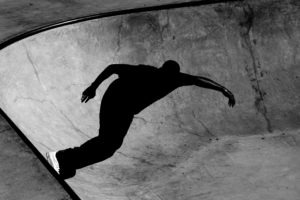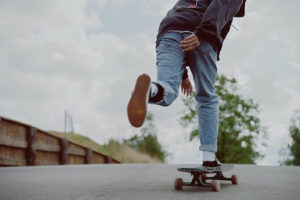Skateboarding means so many different things to different people. It is a form of transportation, a fun cruise, a sport, a community, and so much more. Whether you are aspiring to ride professionally, looking for a new hobby, or hoping to learn a few new tricks, there are safety measures that should be kept in mind every time skateboard wheels hit pavement.
While professionals might make it look easy – for the most part – if you watch them attempting a difficult trick or learning something new, just like anyone, they struggle! Once you move past cruising, skateboarding takes a lot of skill. Trying new things on your skateboard is great, but you should not move too far past your ability before you are ready, for safety reasons.
Just like in any other sport, executing tricks requires patience and a whole lot of practice. Because skaters generally want to improve and continuously push themselves to the best they can be, they can be prone to accidents and injuries. No matter how skilled you are, you will likely leave the skate park with at least a few cuts, scrapes, and bruises! To prevent more serious injuries, there are a few safety elements that are important to keep in mind.
Before you hit the streets or the skate park, check out these skateboard safety tips, be careful, and watch out for others as well – and, have fun!
Skateboarding Safety Gear
One of the most effective ways of maintaining safety when you are on your skateboard is making sure that you are wearing proper protective gear.
Let’s start by talking about having a reliable skateboard helmet. If there is one piece of safety gear that you should have, it is this. The most serious skateboard injuries happen near the head. To protect your head during falls, make sure the helmet fits properly and meets safety standards. Multi-sport skate-focused helmets or a skateboard-specific helmet should do the trick. A general rule for helmets is that they should meet the safety standards of the U.S Consumer Product Safety Commission (CPSC).
Another important piece of safety gear to have are a good pair of wrist guards. Wrist guards are responsible for making sure that your wrists are supported, and they help reduce the chance of breaking or spraining in a fall.
If you want to be fully protected, knee and elbow pads are a must. This safety gear can help prevent broken bones and reduce some of the most common spots for scrapes and bruises during falls on a skateboard. As a general recommendation, go for pads that are snug but do not affect your movement.
Another safety element that is often overlooked, is having proper skateboarding shoes. Not just any old pair of sneakers will do, skate shoes are designed to absorb shock, offer grip, provide cushioning, and allow for more control. As for preference in style, you will learn this over time.
Skateboard Conditioning and Maintenance
Just like anything, proper maintenance and conditioning are important to safety in skateboarding. Always be mindful of the condition of your board and setup. Make sure your bearings are well maintained. Clean them occasionally, to ensure that they perform their best, and check on the condition of your trucks as well. Also, be on the lookout for damaged wheels, and replace them, as necessary. Re-grip your deck with grip tape as needed.
If you want to get more serious on your board, invest in quality equipment. Do not hunt for the absolute best deals, get gear that will hold up to the wear and tear and support you while you ride.
Right Place, Right Time
Generally, it is ideal to go to skate parks and avoid spaces with irregular surfaces with bumps and grooves you might not be familiar with. Make note of your surroundings, if you are still gaining confidence, avoid high traffic areas. Avoid wet surfaces and avoid skating in the rain, as it can lead to accidents, injuries, and can damage your board and affect its longevity.
Do not ride on streets or areas where skateboarding is not allowed, likely it is not allowed for a reason! For trails and areas where you can skateboard, make note of the condition of the pavement, any bumps, or dips to avoid or learn to recognize.
Learning to Fall on a Skateboard
Arguably one of the most important tips in skateboard safety is the value of learning how to fall properly. Learning to fall will help prevent serious injury, keeping you inspired to keep learning and get back on your feet quickly!
To start, what not to do. Do not fall onto your outstretched arms or hands as much as you can help it. Falling in this way, it is highly likely to break or sprain a wrist or arm.
If you can, crouch into your fall, you will be closer to the ground and therefore reduce the severity of the fall. Also, learn to roll into your fall, keeping that momentum will reduce the force of the impact overall. Relax your body as you fall, so you are not tense, and try to land on fleshier, larger parts of your body.
If you are nervous about falling properly, consider practicing on softer surfaces or grassy areas!









Despite their small silhouette, bearings will never go out of my must-consider feature list when it comes to the best longboarding performance. Without bearings, the wheels can’t turn and my longboard will never move despite how the hell I push it. It is a small price to pay rather than compromising the safety of my rides by settling for less. 🙂